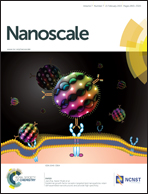Single nanowire manipulation within dielectrophoretic force fields in the sub-crossover frequency regime
Abstract
This paper presents the quantitative relationship between the control parameters of a dielectrophoretic (DEP) force field and the resulting electrokinetic region of influence experienced by individual nanowires (NWs) in colloidal suspensions. Our results show that DEP operation at sub-crossover frequencies, which are defined as frequencies slightly below the transition from positive-to-negative DEP, offers a suitable but previously unexplored performance regime for single NW manipulation and assembly. The low-magnitude DEP forces at these frequencies, which are estimated to be 8 orders of magnitude smaller as compared to near-DC frequencies, provide an efficient avenue to controllably extend electrokinetic influence on suspension volumes that present isolated NWs. These results are demonstrated using α-phase manganese dioxide NWs as a model one-dimensional construct. Based on experimentally extracted values for the NW intrinsic conductivity and dielectric permittivity, we employ computational models to explain each of the performance regimes observed in this nanoassembly system. In addition, we use a new approach to estimate the concentration of a NW suspension from experimentally observed data for deposition yields.


 Please wait while we load your content...
Please wait while we load your content...